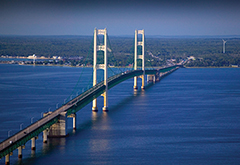Mackinac Bridge
The Mackinac Bridge is a suspension bridge spanning the Straits of Mackinac to connect the Upper and Lower Peninsulas of the U.S. state of Michigan. Opened in 1957, the 26,372-foot-long (4.995 mi; 8.038 km) bridge (familiarly known as "Big Mac" and "Mighty Mac") is the world's 22nd-longest main span and the longest suspension bridge between anchorages in the Western Hemisphere. The Mackinac Bridge is part of Interstate 75 and the Lakes Michigan and Huron components of the Great Lakes Circle Tour across the straits; it is also a segment of the U.S. North Country National Scenic Trail. The bridge connects the city of St. Ignace on the north end with the village of Mackinaw City on the south.
 Envisioned since the 1880s, the bridge was designed by the engineer David B. Steinman and completed in 1957 only after many decades of struggles to begin construction.
Envisioned since the 1880s, the bridge was designed by the engineer David B. Steinman and completed in 1957 only after many decades of struggles to begin construction.
The bridge opened on November 1, 1957, connecting two peninsulas linked for decades by ferries. A year later, the bridge was formally dedicated as the "world's longest suspension bridge between anchorages", allowing a superlative comparison to the Golden Gate Bridge, which had a longer center span between towers, and the San Francisco–Oakland Bay Bridge, which had an anchorage in the middle.
It remains the longest suspension bridge with two towers between anchorages in the Western Hemisphere. Much longer anchorage-to-anchorage spans have been built in the Eastern Hemisphere, including the Akashi Kaikyō Bridge in Japan (6,532 ft or 1,991 m). But the long leadups to the anchorages on the Mackinac make its total shoreline-to-shoreline length of five miles (8.0 km), longer than the Akashi-Kaikyo (2.4 mi or 3.9 km).
The length of the bridge's main span is 3,800 feet (1,158 m), which makes it the third-longest suspension span in the United States and 20th longest suspension span worldwide. It is also one of the world's longest bridges overall. More details
 Envisioned since the 1880s, the bridge was designed by the engineer David B. Steinman and completed in 1957 only after many decades of struggles to begin construction.
Envisioned since the 1880s, the bridge was designed by the engineer David B. Steinman and completed in 1957 only after many decades of struggles to begin construction.The bridge opened on November 1, 1957, connecting two peninsulas linked for decades by ferries. A year later, the bridge was formally dedicated as the "world's longest suspension bridge between anchorages", allowing a superlative comparison to the Golden Gate Bridge, which had a longer center span between towers, and the San Francisco–Oakland Bay Bridge, which had an anchorage in the middle.
It remains the longest suspension bridge with two towers between anchorages in the Western Hemisphere. Much longer anchorage-to-anchorage spans have been built in the Eastern Hemisphere, including the Akashi Kaikyō Bridge in Japan (6,532 ft or 1,991 m). But the long leadups to the anchorages on the Mackinac make its total shoreline-to-shoreline length of five miles (8.0 km), longer than the Akashi-Kaikyo (2.4 mi or 3.9 km).
The length of the bridge's main span is 3,800 feet (1,158 m), which makes it the third-longest suspension span in the United States and 20th longest suspension span worldwide. It is also one of the world's longest bridges overall. More details
